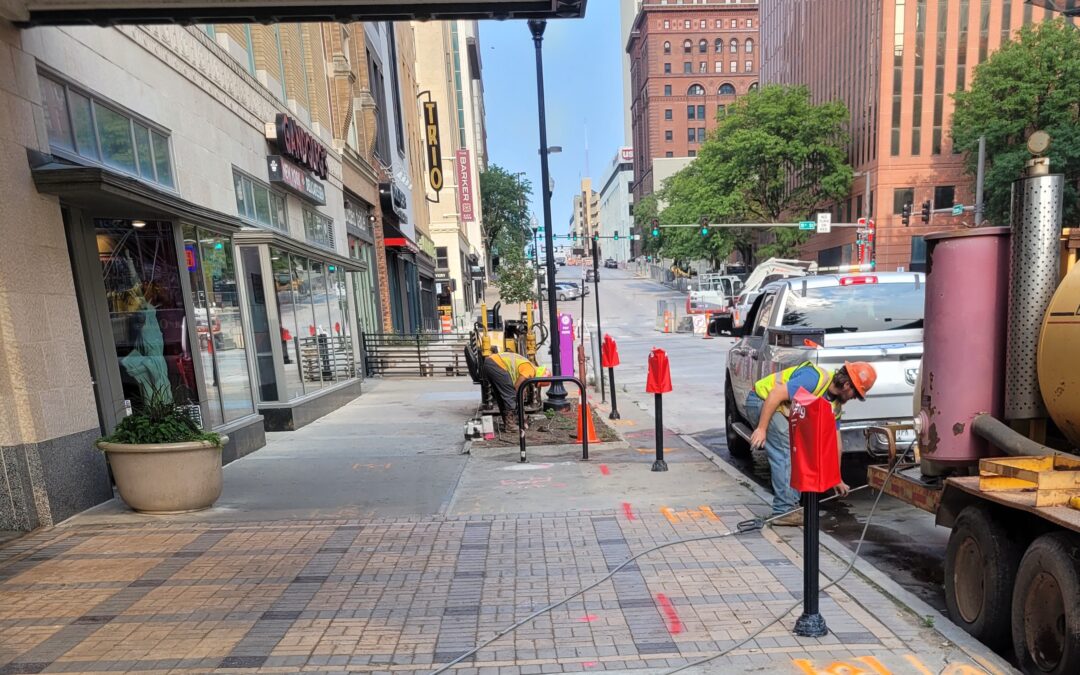The TJ Cable team hard at work in downtown Omaha! Utilizing Horizontal Directional Drilling (HDD), we’re enhancing safety and efficiency – and minimizing disruptions. Unlike traditional trenching, HDD reduces safety risks and protects existing underground utilities, ensuring our city remains intact and connected.
Directional drilling, also known as horizontal directional drilling (HDD), is a trenchless method of installing underground pipelines, cables, and conduit in a precise and efficient manner. Here’s a detailed explanation:
What is Directional Drilling?
Directional drilling involves using a specialized drilling rig to create a bore path underground without the need for traditional excavation methods. This technique is particularly advantageous in situations where surface disruption needs to be minimized, such as under roads, rivers, buildings, and other obstacles.
Key Steps in Directional Drilling:
Planning and Design:
- Surveying: The first step involves a thorough survey of the project site to determine the most suitable path for the drill. Engineers consider soil conditions, existing underground utilities, and the distance and depth required for the installation.
- Bore Path Design: A detailed plan is created to specify the bore path, entry and exit points, and depth. This plan ensures the drilling process avoids existing utilities and environmental features.
Pilot Hole Drilling:
- Drill Rig Setup: The directional drilling rig is set up at the entry point. The drill rig pushes a drill bit attached to a flexible drill string into the ground.
- Steering and Monitoring: Using a combination of hydraulic systems and a steerable drill head, operators guide the drill bit along the pre-planned path. Real-time monitoring with tracking and guidance systems ensures accuracy and control of the bore path.
Reaming (Enlarging the Pilot Hole):
- Reamers: Once the pilot hole is complete, reaming tools are used to enlarge the hole to the required diameter. This step may involve several passes with progressively larger reamers.
Pullback (Pipe Installation):
- Pulling the Pipe: After reaming, the product pipe or conduit is attached to the reamer and pulled back through the bore hole from the exit point to the entry point. This process ensures the pipe is installed along the precise bore path.
Advantages of Directional Drilling:
- Minimal Surface Disruption: HDD reduces the need for open trenching, preserving landscapes and minimizing traffic disruptions.
- Environmental Protection: This method is ideal for environmentally sensitive areas, as it avoids disturbing the surface and ecosystems.
- Cost-Effective: By reducing the need for extensive excavation and restoration, directional drilling can be more economical than traditional methods.
- Versatility: HDD can install pipes and cables under various obstacles, including roads, rivers, and buildings, making it highly versatile.
- Speed and Efficiency: The process is often faster and more efficient, reducing project timelines.
Applications of Directional Drilling:
- Utility Installations: Water, gas, and sewer pipelines, electrical and telecommunications cables.
- Oil and Gas: Installing pipelines for the oil and gas industry.
- Infrastructure Projects: Road crossings, river crossings, and urban utility installations.
Directional drilling is a cutting-edge technique that enhances the efficiency, safety, and environmental sustainability of underground utility installations. By minimizing surface disruption and providing precise control over the drilling process, HDD has become a preferred method in many infrastructure and utility projects.

